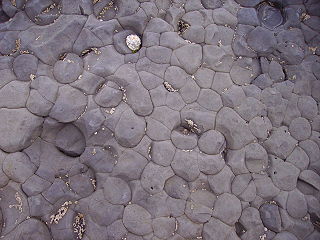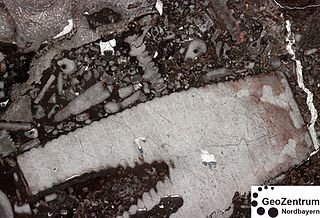
Limestone is a type of carbonate sedimentary rock which is the main source of the material lime. It is composed mostly of the minerals calcite and aragonite, which are different crystal forms of CaCO3. Limestone forms when these minerals precipitate out of water containing dissolved calcium. This can take place through both biological and nonbiological processes, though biological processes, such as the accumulation of corals and shells in the sea, have likely been more important for the last 540 million years. Limestone often contains fossils which provide scientists with information on ancient environments and on the evolution of life.

Sandstone is a clastic sedimentary rock composed mainly of sand-sized silicate grains. Sandstones comprise about 20–25% of all sedimentary rocks.

Sedimentary rocks are types of rock that are formed by the accumulation or deposition of mineral or organic particles at Earth's surface, followed by cementation. Sedimentation is the collective name for processes that cause these particles to settle in place. The particles that form a sedimentary rock are called sediment, and may be composed of geological detritus (minerals) or biological detritus. The geological detritus originated from weathering and erosion of existing rocks, or from the solidification of molten lava blobs erupted by volcanoes. The geological detritus is transported to the place of deposition by water, wind, ice or mass movement, which are called agents of denudation. Biological detritus was formed by bodies and parts of dead aquatic organisms, as well as their fecal mass, suspended in water and slowly piling up on the floor of water bodies. Sedimentation may also occur as dissolved minerals precipitate from water solution.
Sedimentology encompasses the study of modern sediments such as sand, silt, and clay, and the processes that result in their formation, transport, deposition and diagenesis. Sedimentologists apply their understanding of modern processes to interpret geologic history through observations of sedimentary rocks and sedimentary structures.

The lithology of a rock unit is a description of its physical characteristics visible at outcrop, in hand or core samples, or with low magnification microscopy. Physical characteristics include colour, texture, grain size, and composition. Lithology may refer to either a detailed description of these characteristics, or a summary of the gross physical character of a rock. Examples of lithologies in the second sense include sandstone, slate, basalt, or limestone.

Mudstone, a type of mudrock, is a fine-grained sedimentary rock whose original constituents were clays or muds. Mudstone is distinguished from shale by its lack of fissility.
The Folk classification, in geology, is a technical descriptive classification of sedimentary rocks devised by Robert L. Folk, an influential sedimentary petrologist and Professor Emeritus at the University of Texas.

The Dunham classification system for carbonate sedimentary rocks was originally devised by Robert J. Dunham in 1962, and subsequently modified by Embry and Klovan in 1971 to include coarse-grained limestones and sediments that had been organically bound at the time of deposition. The modified Dunham Classification has subsequently become the most widely employed system for the classification of carbonate sedimentary rocks with 89% of workers currently adopting this system over the alternative Folk classification scheme

Clastic rocks are composed of fragments, or clasts, of pre-existing minerals and rock. A clast is a fragment of geological detritus, chunks, and smaller grains of rock broken off other rocks by physical weathering. Geologists use the term clastic to refer to sedimentary rocks and particles in sediment transport, whether in suspension or as bed load, and in sediment deposits.

A carbonate platform is a sedimentary body which possesses topographic relief, and is composed of autochthonic calcareous deposits. Platform growth is mediated by sessile organisms whose skeletons build up the reef or by organisms which induce carbonate precipitation through their metabolism. Therefore, carbonate platforms can not grow up everywhere: they are not present in places where limiting factors to the life of reef-building organisms exist. Such limiting factors are, among others: light, water temperature, transparency and pH-Value. For example, carbonate sedimentation along the Atlantic South American coasts takes place everywhere but at the mouth of the Amazon River, because of the intense turbidity of the water there. Spectacular examples of present-day carbonate platforms are the Bahama Banks under which the platform is roughly 8 km thick, the Yucatan Peninsula which is up to 2 km thick, the Florida platform, the platform on which the Great Barrier Reef is growing, and the Maldive atolls. All these carbonate platforms and their associated reefs are confined to tropical latitudes. Today's reefs are built mainly by scleractinian corals, but in the distant past other organisms, like archaeocyatha or extinct cnidaria were important reef builders.
Cyclic sediments are sequences of sedimentary rocks that are characterised by repetitive patterns of different rock types (strata) or facies within the sequence. Processes that generate sedimentary cyclicity can be either autocyclic or allocyclic, and can result in piles of sedimentary cycles hundreds or even thousands of metres thick. The study of sequence stratigraphy was developed from controversies over the causes of cyclic sedimentation.

Under the Dunham classification system of limestones, a wackestone is defined as a mud-supported carbonate rock that contains greater than 10% grains. Most recently, this definition has been clarified as a carbonate-dominated rock in which the carbonate mud component supports a fabric comprising 10% or more very fine-sand grade or larger grains but where less than 10% of the rock is formed of grains larger than sand grade .

Under the Dunham classification system of limestones, a grainstone is defined as a grain-supported carbonate rock that contains less than 1% mud-grade material. This definition has recently been clarified as a carbonate-dominated rock that does not contain any carbonate mud and where less than 10% of the components are larger than 2 mm. The spaces between grains may be empty (pores) or filled by cement.

Under the Dunham classification system of limestones, a packstone is defined as a grain-supported carbonate rock that contains 1% or more mud-grade fraction. This definition has been clarified by Lokier and Al Junaibi (2016) as a carbonate-dominated lithology containing carbonate mud in a fabric supported by a sand grade grain-size fraction and where less than 10% of the volume consists of grains >2 mm.

Floatstone is a type of carbonate rock.
Rhizoliths are organosedimentary structures formed in soils or fossil soils (paleosols) by plant roots. They include root moulds, casts, and tubules, root petrifactions, and rhizocretions. Rhizoliths, and other distinctive modifications of carbonate soil texture by plant roots, are important for identifying paleosols in the post-Silurian geologic record. Rock units whose structure and fabric were established largely by the activity of plant roots are called rhizolites.

Rudstone is a type of carbonate rock.
A boundstone is a special type of carbonate rock in the Dunham classification
Bindstone is a special type of carbonate rock in the Dunham classification. The term did not appear in the original Dunham classification from 1962 and was introduced by Embry and Klovan 1971 in the modified Dunham classification.
A framestone is a special type of carbonate rock in the Dunham classification.












